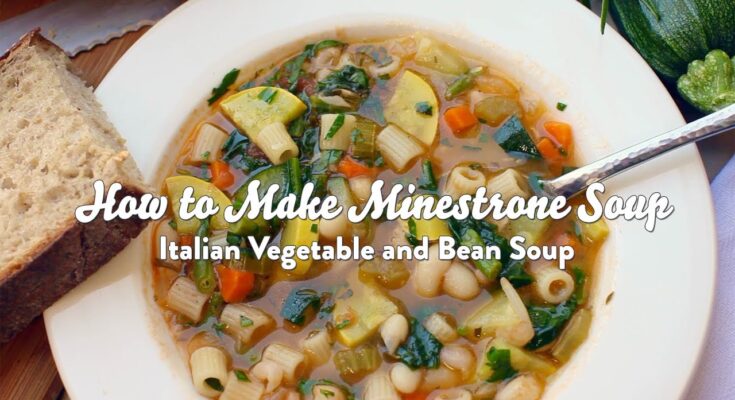Minestrone Soup Recipe: Minestrone soup is the very definition of hearty comfort food. Originating from Italy, this thick, chunky vegetable soup is a medley of seasonal produce, legumes, pasta, and sometimes meat. What makes minestrone unique isn’t just its robust flavor but its flexibility. There’s no single “correct” recipe. It’s the perfect dish for cleaning out your fridge or putting those garden vegetables to good use.
Think of it as a warm hug in a bowl. Whether you’re enjoying it on a cold winter night or serving it chilled during the warmer months, it never fails to satisfy. Unlike other soups that may rely heavily on broth, minestrone leans on its hearty ingredients to build volume and texture. It’s rustic, filling, and incredibly nourishing.
History and Origin
The roots of minestrone date back to ancient Roman times, when diets consisted largely of vegetables and legumes due to the high cost of meat. It started as a “poor man’s soup,” a simple concoction thrown together with whatever ingredients were readily available. Over centuries, regional variations developed—some rich with beans and greens in the north, others tomato-heavy in the south.
By the 17th century, with the introduction of new vegetables from the Americas (like tomatoes and potatoes), the recipe evolved into what we now recognize as classic minestrone. Despite its humble beginnings, it gained popularity worldwide and is now featured in high-end Italian restaurants and home kitchens alike.
Why You’ll Love This Recipe
If versatility had a flavor, it would be minestrone soup. What sets this recipe apart is its adaptability. Whether you’re vegetarian, vegan, gluten-free, or just a fan of one-pot meals, this soup can be tailored to suit your needs. It’s perfect for meal prep, easy on the wallet, and a guaranteed crowd-pleaser.
Here’s why this version of minestrone soup might become your new favorite:
- It’s loaded with veggies, making it super healthy.
- One pot is all you need—less mess, less fuss.
- It’s meal-prep friendly and freezes beautifully.
- You can swap ingredients based on what’s in your fridge.
- It’s comforting, flavorful, and perfect for all seasons.
Ingredients Overview
Fresh Vegetables
At the heart of any minestrone soup is a generous helping of vegetables. The beauty of this dish is that it doesn’t rely on fancy or hard-to-find ingredients. You’ll typically find a base of onions, carrots, and celery—collectively known as mirepoix—used to build flavor. From there, it’s all about layering in more color and texture.
Here are some go-to veggies that work great in this soup:
- Zucchini – mild and juicy
- Green beans – slightly crunchy, adds texture
- Spinach or kale – a leafy green for added nutrients
- Potatoes – hearty and satisfying
- Cabbage – another great fiber-rich filler
Remember, there’s no strict rule here. If you’ve got leftover bell peppers, squash, or even broccoli, toss them in. Minestrone welcomes improvisation.
Legumes and Pasta
Legumes add protein and bulk, making the soup more satisfying. Cannellini beans are a classic choice, but kidney beans, garbanzo beans, or even lentils can work just as well. As for pasta, short shapes are your best bet—think elbow macaroni, ditalini, or small shells. These cook quickly and integrate nicely without overwhelming the soup.
Pro tip: Cook pasta separately and add it to each serving to avoid it getting mushy in leftovers.
Herbs and Spices
While the vegetables carry a lot of the flavor, herbs and spices are what tie it all together. Fresh herbs like basil, thyme, and parsley are traditional, but dried Italian seasoning also works in a pinch. Garlic, bay leaves, and a hint of red pepper flakes can elevate the flavor to restaurant-quality.
A good quality vegetable or chicken broth is essential, as it acts as the canvas for all the flavors to mingle. Don’t forget a drizzle of olive oil and a sprinkle of Parmesan just before serving—it brings the entire bowl to life.
Essential Kitchen Tools
Before diving into the cooking process, it helps to have the right tools ready. Here’s what you’ll need:
- Large pot or Dutch oven – For even heat distribution
- Sharp knife and cutting board – Essential for prepping veggies
- Wooden spoon – For sautéing and stirring
- Ladle – Makes serving easier
- Measuring cups and spoons – For accuracy, especially with spices
These tools make the process smoother and ensure you’ll be enjoying a perfectly cooked minestrone soup without the hassle.
Step-by-Step Guide to Making Minestrone Soup
Step 1: Prepping the Ingredients
Preparation is key to any great soup, and minestrone is no different. Before you even heat the pot, make sure all your vegetables are washed, peeled, and chopped. This will save you from scrambling midway through the cooking process. Aim for uniform sizes so everything cooks evenly. Here’s a quick checklist to help streamline your prep:
- Dice the onions, carrots, and celery – this aromatic trio is your flavor base.
- Chop potatoes into bite-sized cubes.
- Slice zucchini or any squash you’re using.
- Trim green beans into 1-inch pieces.
- Mince garlic for a bold aroma.
- Drain and rinse canned beans if not using freshly cooked ones.
This phase is also a great opportunity to measure out your spices and have your broth ready to pour in. Having a mise en place (everything in its place) will make the entire cooking process a breeze.
Step 2: Sautéing the Base
This is where the magic begins. Heat olive oil in a large Dutch oven or soup pot over medium heat. Start by sautéing your diced onions until they’re translucent and fragrant—about 5 minutes. Then, add the carrots and celery, letting them soften slightly while stirring occasionally. Garlic goes in last so it doesn’t burn, releasing its aroma and infusing the base with rich flavor.
This aromatic mix is the foundation of your soup. It’s what gives minestrone its comforting taste and depth. Don’t rush this step. A good sauté not only enhances the vegetables’ natural sweetness but also prepares the base to absorb more complex layers of flavor from the broth and herbs.
Optional but recommended: add a tablespoon of tomato paste and sauté for another 2-3 minutes. This intensifies the tomato flavor and gives your soup a deeper, umami-rich profile.
Step 3: Building the Flavor
Once your base is golden and fragrant, it’s time to build your soup. Add the chopped potatoes, zucchini, and green beans to the pot. Stir to coat them in the aromatic oil and veggies, letting everything mingle for a few minutes.
Now, pour in your vegetable broth or chicken stock. The amount can vary depending on how thick you want your soup, but generally, 6-8 cups is a good starting point. Stir in canned diced tomatoes and add your seasonings—bay leaves, dried herbs, and a dash of salt and pepper.
This is also the stage where you add your beans. Whether you’re using cannellini, kidney, or garbanzo, they bring creaminess and heartiness to the dish.
Bring everything to a gentle boil, then reduce the heat and let it simmer. The longer it simmers, the more flavorful it becomes. Give it at least 20-30 minutes, checking occasionally and stirring to prevent sticking.
Step 4: Simmer and Season
Simmering is when the real magic happens. As the soup gently bubbles, the flavors meld and the vegetables soften to perfection. This slow cooking process allows the beans to absorb the herby broth and the vegetables to release their juices, enriching the overall taste.
During this phase, taste the broth and adjust the seasonings. You may need to add more salt, a pinch of sugar to balance acidity from the tomatoes, or even a splash of vinegar or lemon juice to brighten the flavor.
Add your pasta in the last 10-12 minutes of cooking. This ensures it doesn’t get mushy and maintains a pleasant bite. Stir occasionally to make sure the pasta doesn’t stick to the bottom of the pot.
Pro tip: If you’re meal prepping or planning to freeze leftovers, cook the pasta separately and add it to individual bowls before serving. This keeps it from soaking up all the broth during storage.
Step 5: Finishing Touches
You’ve simmered your soup to perfection—now it’s time to elevate it with a few final flourishes. Just before serving, stir in a handful of chopped fresh spinach or kale. These greens wilt quickly and add a burst of color and nutrients to the dish.
Drizzle a good-quality olive oil over each bowl before serving. It adds richness and brings out the earthy flavors. A generous grating of Parmesan cheese on top takes it from homey to gourmet in seconds.
For an extra layer of complexity, add a dash of balsamic vinegar or a squeeze of lemon juice just before serving. It brightens the entire dish and ties all the flavors together beautifully.
Serve it hot with a crusty piece of bread or a side of garlic toast, and you’ve got a meal that’s as nourishing as it is delicious.
Serving Suggestions
Minestrone soup is incredibly versatile when it comes to serving. It’s a complete meal on its own, but a few smart pairings can turn it into a gourmet experience. Here are a few ideas:
- Crusty bread – A slice of sourdough or ciabatta for dipping.
- Grilled cheese sandwich – The melty goodness complements the hearty soup.
- Simple salad – A fresh green salad with a lemon vinaigrette balances the richness.
- Garlic bread or focaccia – Adds an indulgent, savory touch.
Presentation tip: Serve it in a deep, wide bowl with a sprinkle of fresh herbs or a swirl of pesto on top. Not only does it enhance the taste, but it also makes it Instagram-worthy.
Storage and Reheating Tips
Leftover minestrone soup is a gift that keeps on giving. Its flavors actually deepen and improve after a day or two in the fridge, making it a dream meal prep option. Whether you’ve made a big batch for the week or want to freeze some for later, here’s how to store and reheat it the right way.
Refrigerating
Let the soup cool to room temperature before transferring it into airtight containers. It will keep well in the fridge for up to 5 days. If your soup has pasta already mixed in, be aware that it will continue to absorb liquid and may become softer over time. To avoid this, store the pasta separately or undercook it slightly.
Freezing
Minestrone freezes beautifully—minus the pasta. Pasta tends to turn mushy when frozen and thawed. If you’re planning to freeze portions, skip the pasta and add it fresh when you reheat the soup. Use freezer-safe containers or zip-top bags, leaving a bit of room at the top for expansion. Label them with the date, and you’re good for up to 3 months.
Reheating
Reheat refrigerated soup on the stovetop over medium heat until warmed through. Add a splash of broth or water if it’s too thick. If you’re reheating from frozen, thaw it overnight in the fridge for best results. Then warm it gently on the stove or microwave in a microwave-safe container, stirring occasionally.
Bonus Tip: When reheating, refresh the flavor by adding a sprinkle of salt, fresh herbs, or a drizzle of olive oil. You’ll bring those original notes back to life with ease.
Customization Ideas
Minestrone soup is incredibly flexible. No two bowls need to look (or taste) the same. Whether you’re accommodating dietary needs or simply trying to use up what’s in your fridge, here are a few creative ways to switch things up:
Make it Vegan
Skip the Parmesan cheese and make sure your broth is 100% plant-based. For a savory, umami-rich twist without the dairy, stir in some nutritional yeast or a dollop of vegan pesto. You can even toss in a bit of coconut cream for a creamy, hearty vegan variation.
Make it Gluten-Free
Replace traditional pasta with gluten-free options like brown rice pasta, chickpea pasta, or even quinoa. Another idea? Add more beans or diced potatoes to replace pasta entirely. Always double-check your broth ingredients too—some store-bought varieties contain hidden gluten.
Add More Protein
While minestrone is already filling, you can boost its protein content with these additions:
- Cooked chicken or turkey – Shredded and stirred in at the end.
- Tofu or tempeh – Cubed and sautéed for a plant-based punch.
- Lean ground beef or sausage – Browned with the veggies in the beginning.
- Lentils – A great plant-based option that thickens the soup naturally.
You can also toss in an egg or two and gently swirl them in while the soup is simmering for a silky, egg-drop-style twist.
FAQs about Minestrone Soup Recipe
1. What is minestrone soup?
Minestrone is a classic Italian soup loaded with vegetables, beans, pasta, and often a savory tomato base. It’s hearty, flavorful, and can easily be customized to include your favorite veggies or pasta shapes.
2. Can I make minestrone soup vegan or vegetarian?
Absolutely! Minestrone soup is often vegan-friendly by default since it’s typically made with vegetables and vegetable broth. For a vegetarian option, you can add some cheese as a garnish, like Parmesan, but skip it for a fully vegan soup.
3. What are the best vegetables for minestrone soup?
Common vegetables include carrots, celery, zucchini, spinach, and tomatoes. Feel free to add or substitute with what you have on hand, like green beans or kale, for extra nutrition.
4. Can I use canned beans?
Yes, canned beans work well and save time. Rinse them before adding to reduce the sodium content. You can also use dried beans, but they need to be cooked first to ensure tenderness.
5. How can I make minestrone soup thicker?
For a thicker texture, you can add extra vegetables, blend a portion of the soup, or stir in some mashed potatoes. Some also add a spoonful of tomato paste for a richer consistency.
6. How long does minestrone soup last in the fridge?
Minestrone soup keeps well for 3–4 days when stored in an airtight container in the refrigerator. It’s also freezer-friendly, so you can make a big batch and freeze portions for quick, ready-to-eat meals.
7. Can I add pasta to minestrone soup?
Yes, pasta is a common addition! Small pasta shapes like macaroni or ditalini work best. Cook the pasta separately if you plan to store leftovers, as pasta can become too soft in the soup over time.
Conclusion
Minestrone soup is more than just a bowl of veggies and broth—it’s a canvas for culinary creativity. Rooted in Italian tradition and infused with the essence of rustic home cooking, this soup manages to be both nourishing and indulgent at the same time. From its humble beginnings to its modern-day adaptability, minestrone proves that great food doesn’t need to be complicated.
Whether you’re new to cooking or a seasoned pro, this recipe is foolproof, satisfying, and endlessly customizable. The flavors are deep, the textures are varied, and the possibilities are endless. Plus, it’s one of those rare dishes that gets even better with time. So make a big pot, enjoy it fresh, and save some for later—it’s the gift of comfort in a bowl, every single time.
References
For additional reading and to verify the information presented in this Minestrone Soup Recipe, here are some reputable sources that provide insights into traditional minestrone soup ingredients, cooking methods, and variations:
- AllRecipes – A comprehensive recipe collection site, offering diverse minestrone variations, tips, and cooking techniques. Visit AllRecipes
- Food Network – Expert chefs share their insights and recipes, along with helpful video tutorials for making authentic minestrone. Explore Food Network
- Serious Eats – A trusted source for culinary guides and recipes, including scientific explanations behind cooking techniques and ingredient choices in minestrone. Read Serious Eats
- BBC Good Food – Known for reliable and tested recipes, BBC Good Food offers a range of minestrone recipes, from classic to seasonal variations. Check BBC Good Food
Each of these sources offers valuable perspectives and information to enhance your understanding and enjoyment of minestrone soup.



